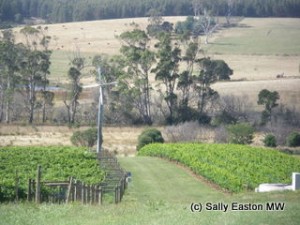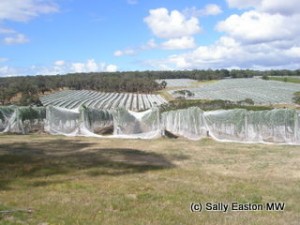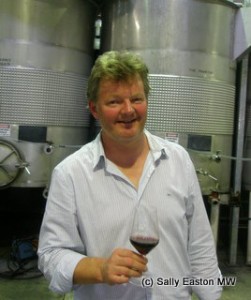Skinny – a new era for Aussie chardonnay?

Cool fruit?
A version of this article first appeared in the Drinks Business, September 2012.
Forget skinny lattes, skinny is a new model for Aussie chardonnay – lean, maybe a bit mean, very clean, even edging to green. The style has been around for a while, as Tom Carson, winemaker at Yabby Lake in the Mornington Peninsula explained “these wines have been here in Australia but they didn’t have too much of a voice. Now, everyone is talking about these wines, and how fine they are.”
So have big, boldly-oaky, bruising chardonnays had their day as consumers are looking for greater freshness, less alcohol and less overt oak? Skinny chardonnay is all about reinventing the grape variety (there’s a lot of it planted); competing with Aussie new-love sauvignon blanc, and trading on trendy cool climate stylistics.
Certainly the style is easier to make in reasonably cool locations: picked early, often made without malolactic fermentation to maximise freshness and natural acidity, with less new oak. It’s all about the steely style with the steel, tight white flowers and citrus to the fore. Aussies often discuss it in terms of a ‘Chablis style’ but this may do a disservice to the style evolution in Australia, and nor does it account for noted stylistic variation within Chablis – with/out oak; with/out malo etc.
For Adam Eggins, chief winemaker at Wakefield/Taylors in the Clare Valley, the aim of the new chardonnay order is medium-bodied wines that are flavoursome, elegant with a juiciness to the fruit texture along with a restraint and savoury notes that have more ageing potential than the big, oaky, early-maturing styles of old. This, he said, is likely to involve new clones, whole bunch pressing, no malo, and tight-grained French oak, among other things. In order to go down this path, he described being on a “journey with winemaking to respect the fruit. Winemakers need the strength to intervene minimally; the strength to do less.”
Eggins attributed the genesis of this style evolution to French clones becoming newly available in Australia, brought in by Yalumba nursery at the turn of the millennium. He said “prior to this our entire chardonnay asset was Mendoza [clone]. We started replanting chardonnay vineyards, which takes years. Now, some exciting wines are coming through because of clonal change.”

Protecting the fruit at Yabby Lake
Carson agreed, saying “a lot of Aussie chardonnay is made from clones promoted in the early 1980s – I10, V1, V3 and V5 – where the idea was if it yielded a lot, it was a good clone.” This sounds all too like European viticulture in the 60s. At Yabby Lake, Carson likes Penfolds 58, and Mendoza, “which has a lot of hen and chicken, it’s low yielding and retains natural acidity well.” And they’ve grafted merlot parcels over to some of the Dijon clones.
These new clones also work for Marty Edwards of The Lane in the Adelaide Hills too. He said his chardonnay, from a 1.2ha patch, is all about site specifics and his use of 100% wild ferment and Dijon clones gives a wine “that’s not overworked. It has a spine of acidity off which the flavours hang … and has authenticity and a sense of place.”
In terms of freshness and quality site selection is crucial. Eggins said “for an average wine [chardonnay] can grow anywhere, but for top quality it’s all about site selection” and what you do with that selection, he said, which includes respecting the terroir of the grape variety. He warned of selecting a too cool site, saying “if you go to the green edge of the dark force, and you get a cool year, or a cold snap, you may not actually ripen it.” Something the French are used to struggling with, but such a phenomenon is new to Australia.
He also suggested the Clare Valley may be too hot for chardonnay. Wakefield/Taylors now bring in Adelaide Hills and Margaret River fruit, choosing these regions because “if we were too big and heavy in the past, we need to make sure we don’t make them too lean and green in the future.”

Michael Glover, Bannockburn
Michael Glover, the winemaker at Bannockburn Vineyards in Geelong, has faced the green dark side, with different consequences. Picking early is a big part of the equation to give leaner fruit, higher natural acidity and lower alcohol, but a minimal ripeness needs to be achieved. He said “I’ve been picking earlier and earlier. I started at 12.8 Baumé (Be), down to 11.5 Be. And as we pick earlier, then the malolactic comes in to flesh out the wine.” He’s currently settled on early picking with malo and time on lees, but he said “there is no recipe. You have to be aware of oak and oxygen, and wary that you don’t lose character.”
He also warned “you can’t go low alcohol if the fruit is not immaculate. If you’re cropping high, you have to go high alcohol because ripeness comes later” with a high crop load. A small crop load can be picked ripe, earlier. He added “as we’ve made less alcoholic wines, we’ve made better wines.” Glover’s drivers for chardonnay are restraint and texture, things he seems to achieve with ease in the wines.
Carson reckons “chardonnay shouldn’t go much above 13%” alcohol. How very European.
To fight back against high alcohol, Yabby Lake’s group viticulturist Keith Harris said “Tom likes to pick at 7g/l acid. If the green flavours are gone, we pick. The sugars tend to be close to 11 to 12 Be.”
At Yabby Lake chardonnay is hand-harvested, then whole bunch pressed with an indigenous ferment on full solids. Carson said “there’s no malolactic fermentation. It’s on lees for 12 months, with just 8-12% new oak, in 500 litre barrels” for less overt oak influence than the 225-litre barrique offers, which had become all but ubiquitous across Australia.
Fellow Mornington Peninsula producer Mike Aylward of Ocean Eight created Verve Chardonnay specifically to appeal to consumers wanting a fresher, tighter, lighter, lean and clean style which is “good for summer and to compete with sauvignon blanc”, and he said “once you know the style [you want to make], then everything you do in the vineyards and winery comes from this.” Such things as enough canopy to keep the fruit shaded and crisp, so very little leaf plucking is done. And, he said “we pick chardonnay just past sparkling base. I want grapefruit, lemon and lime, not stone fruit.” He picks about a week before most do. All of it goes to older oak.
But how far is too far on the early-picking schedule? When does skinny chardonnay become thin, mean, tart and austere? Edwards said “it’s almost a race to see who can have the skinniest, thinnest, most metallic chardonnay. We’re not aiming for 12% of alcohol, but there’s an element of not knowing how far you can go until you’ve gone too far.”
My research visit to Australia in February 2012 was sponsored by Wine Australia and Wine Tasmania.



